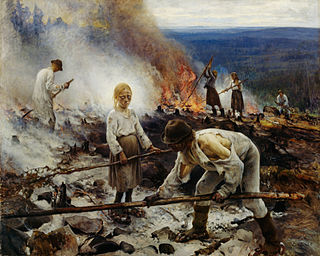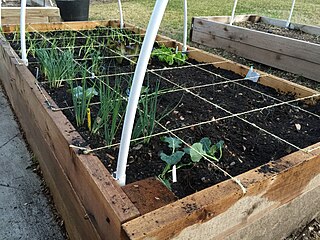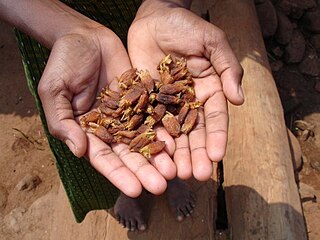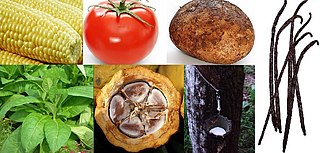The primary sector of the economy includes any industry involved in the extraction and production of raw materials, such as farming, logging, hunting, fishing, forestry and mining.
The following outline is provided as an overview of and topical guide to agriculture:

Intensive agriculture, also known as intensive farming, conventional, or industrial agriculture, is a type of agriculture, both of crop plants and of animals, with higher levels of input and output per unit of agricultural land area. It is characterized by a low fallow ratio, higher use of inputs such as capital and labour, and higher crop yields per unit land area.

Pasture is land used for grazing. Pasture lands in the narrow sense are enclosed tracts of farmland, grazed by domesticated livestock, such as horses, cattle, sheep, or swine. The vegetation of tended pasture, forage, consists mainly of grasses, with an interspersion of legumes and other forbs. Pasture is typically grazed throughout the summer, in contrast to meadow which is ungrazed or used for grazing only after being mown to make hay for animal fodder. Pasture in a wider sense additionally includes rangelands, other unenclosed pastoral systems, and land types used by wild animals for grazing or browsing.

The milkfish is the sole living species in the family Chanidae. However, there are at least five extinct genera from the Cretaceous. The repeating scientific name (tautonym) is from Greek khanos.

Slash-and-burn agriculture is a farming method that involves the cutting and burning of plants in a forest or woodland to create a field called a swidden. The method begins by cutting down the trees and woody plants in an area. The downed vegetation, or "slash", is then left to dry, usually right before the rainiest part of the year. Then, the biomass is burned, resulting in a nutrient-rich layer of ash which makes the soil fertile, as well as temporarily eliminating weed and pest species. After about three to five years, the plot's productivity decreases due to depletion of nutrients along with weed and pest invasion, causing the farmers to abandon the field and move over to a new area. The time it takes for a swidden to recover depends on the location and can be as little as five years to more than twenty years, after which the plot can be slashed and burned again, repeating the cycle. In Bangladesh and India, the practice is known as jhum or jhoom.

The pinyon or piñon pine group grows in southwestern North America, especially in New Mexico, Arizona, and Utah. The trees yield edible nuts, which are a staple food of Native Americans, and widely eaten as a snack and as an ingredient in New Mexican cuisine. The name comes from the Spanish pino piñonero, a name used for both the American varieties and the stone pine common in Spain, which also produces edible nuts typical of Mediterranean cuisine. Harvesting techniques of the prehistoric American Indians are still used today to collect the pinyon seeds for personal use or for commercialization. The pinyon nut or seed is high in fats and calories.
In agriculture, succession planting refers to several planting methods that increase crop availability during a growing season by making efficient use of space and timing.

Harvesting is the process of gathering a ripe crop from the fields. Reaping is the cutting of grain or pulse for harvest, typically using a scythe, sickle, or reaper. On smaller farms with minimal mechanization, harvesting is the most labor-intensive activity of the growing season. On large mechanized farms, harvesting uses the most expensive and sophisticated farm machinery, such as the combine harvester. Process automation has increased the efficiency of both the seeding and harvesting processes. Specialized harvesting equipment utilizing conveyor belts to mimic gentle gripping and mass-transport replaces the manual task of removing each seedling by hand. The term "harvesting" in general usage may include immediate postharvest handling, including cleaning, sorting, packing, and cooling.

Square foot gardening is the practice of dividing the growing area into small square sections, typically 1 foot (30 cm) on a side, hence the name. The aim is to assist the planning and creating of a small but intensively planted vegetable garden. It results in a simple and orderly gardening system, from which it draws much of its appeal. Mel Bartholomew coined the term "square foot gardening" in his 1981 book of the same name.

Baby corn is a cereal grain taken from corn (maize) harvested early while the stalks are still small and immature. It typically is eaten whole — cob included — in contrast to mature corn, whose cob is too tough for human consumption. It is eaten both raw and cooked. Baby corn is common in stir fry dishes.
Gather, gatherer, or gathering may refer to:

Non-timber forest products (NTFPs) are useful foods, substances, materials and/or commodities obtained from forests other than timber. Harvest ranges from wild collection to farming. They typically include game animals, fur-bearers, nuts, seeds, berries, mushrooms, oils, sap, foliage, pollarding, medicinal plants, peat, mast, fuelwood, fish, insects, spices, and forage. Overlapping concepts include non-wood forest products (NWFPs), wild forest products, minor forest produce, special, minor, alternative and secondary forest products – for further distinctions see the definition section below

A crop is a plant that can be grown and harvested extensively for profit or subsistence. Crops may refer either to the harvested parts or to the harvest in a more refined state. Most crops are cultivated in agriculture or aquaculture. A crop may include macroscopic fungus, or macroscopic marine alga.
Forest farming is the cultivation of high-value specialty crops under a forest canopy that is intentionally modified or maintained to provide shade levels and habitat that favor growth and enhance production levels. Forest farming encompasses a range of cultivated systems from introducing plants into the understory of a timber stand to modifying forest stands to enhance the marketability and sustainable production of existing plants.

Intensive crop farming is a modern industrialized form of crop farming. Intensive crop farming's methods include innovation in agricultural machinery, farming methods, genetic engineering technology, techniques for achieving economies of scale in production, the creation of new markets for consumption, patent protection of genetic information, and global trade. These methods are widespread in developed nations.

Ecological farming is recognised as the high-end objective among the proponents of sustainable agriculture. Ecological farming is not the same as organic farming, however there are many similarities and they are not necessarily incompatible. Ecological farming includes all methods, including organic, which regenerate ecosystem services like: prevention of soil erosion, water infiltration and retention, carbon sequestration in the form of humus, and increased biodiversity. Many techniques are used including no till, multispecies cover crops, strip cropping, terrace cultivation, shelter belts, pasture cropping etc.
Indigenous horticulture is practised in various ways across all inhabited continents. Indigenous refers to the native peoples of a given area and horticulture is the practice of small-scale intercropping.
French intensive gardening also known as raised bed, wide bed, or French market gardening is a method of gardening in which plants are grown within a smaller space and with higher yields than other traditional gardening methods. The main principles for success are often listed as soil improvement, raised beds, close spacing, companion planting, succession planting and crop rotation. Originating in France, the practice is popular among urban gardeners and small for profit farming operations.
This glossary of agriculture is a list of definitions of terms and concepts used in agriculture, its sub-disciplines, and related fields. For other glossaries relevant to agricultural science, see Glossary of biology, Glossary of ecology, Glossary of environmental science, and Glossary of botany.










